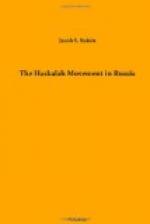Trade schools were opened by the Committee for the Promotion of a Knowledge of Trade and Agriculture among the Jews of Russia, in Minsk, Vilna, and Vitebsk, besides fifteen manual training schools for boys and twenty for girls, in which the indigent pupils are provided with food, clothes, and books. In 1900 thirteen new schools were opened in Kherson and Yekaterinoslav, to supply the educational demand of the thirty-eight colonies existing in those Governments. In the vicinity of Minsk a Junior Republic was organized, and in many cities art and choral societies were formed.[16]
The desire for self-help and the tendency towards organization, to which Zionism gave an impetus, was rapidly reflected in every sphere of Russo-Jewish activity. In a series of works and articles, Jacob Wolf Mendlin, who studied under Lassalle, pointed out the importance of the co-operative system. Accordingly, a union was organized by the Jewish salesmen in Warsaw. In 1897 a conference of Jewish workingmen was held in that city and Der allgemeine juedische Arbeiterbund in Littauen, Polen, und Russland (Federation of Jewish Labor Unions in Lithuania, Poland, and Russia) was perfected. It published three papers as its organs, Die Arbeiterstimme, Der juedischer Arbeiter, and, in Switzerland, Letzte Nachrichten. Soon workmen’s associations and artisans’ clubs appeared wherever there was a sufficient number of Jewish tailors, hatters, bookbinders, etc., for the purpose of increasing and improving the value of their production, and to do away with middlemen and money-lenders. They organized a tailors’, dyers’, and shoemakers’ union in Kharkov, and a carpenters’ union in Minsk, for mutual support in the struggle for existence, and for the construction of sanitary workingmen’s houses. The cultural desire of the handicraftsmen, constituting twelve per cent of the Russo-Jewish population and occasionally fifty-two per cent (Odessa), seventy-three per cent (Kovno), and even ninety per cent (Byelostok), is phenomenal. Their object is not only physical improvement. Their highest aim is that their members be enabled, by means of efficient night schools and private instruction, to acquire elementary and higher education; in the words of the constitution of the carpenters’ union of Minsk, “to protect their material interests, raise their moral and intellectual status, and foster efforts of self-help."[17]
The Hebrew teachers, a class which, though more respected, underwent as hard a struggle as the workingmen, banded themselves together in 1899 in the Society for Aiding Hebrew Teachers of the Province of Vilna. Their president was Michael Wolper, the inspector of the Hebrew Institute and successor to Wohl as censor of Hebrew publications. Similar attempts were made in Bessarabia. Rabbi Shachor, chairman of the Hebrew Teachers’ Association of Yekaterinoslav, was instrumental in opening a normal school conducted on Chautauqua principles, and so advanced the cause of education considerably.[18]




